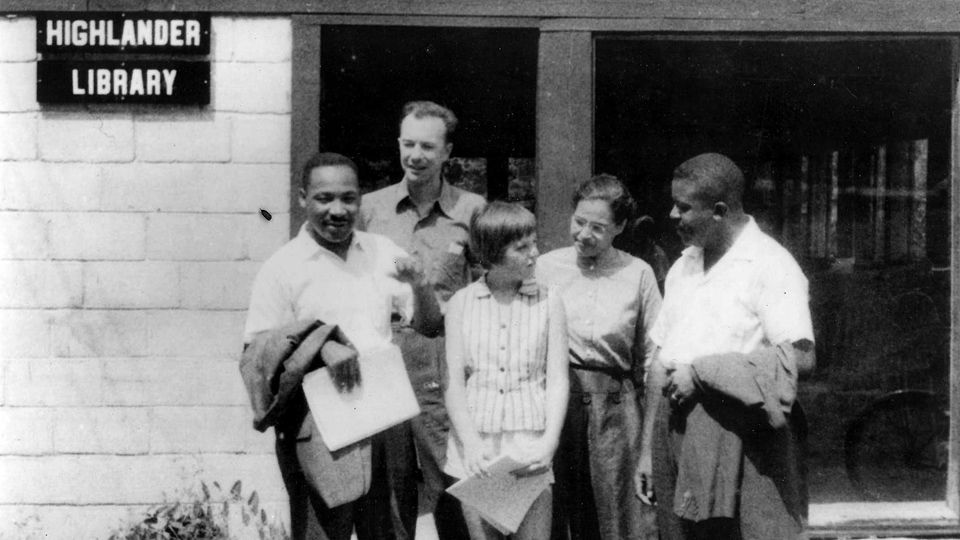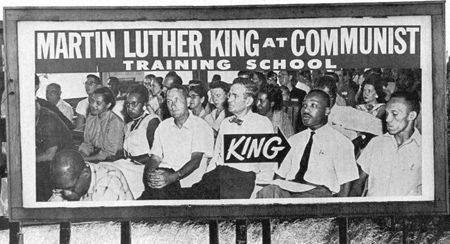
UPDATE: The Sierra Club has been working with the Highlander Center for years, helping to shape and transform their Environmental Justice work.
The Sierra Club reached out to the Highlander Center this week. They are committed to rebuilding now and not letting white supremacists stop their critical work. In this time of need, they need all of our support.
If you can, join people across the region by making an emergency donation.
The deadly racist spree in Charlottesville in 2017 and the killing of 11 congregants at the Tree of Life Synagogue in Pittsburg in 2018 were fire bells in the night. Another rang out in New Market, Tennessee, on March 29 as the main building at the Highlander Research and Education Center burned to the ground, along with archives.
In the nearby parking lot, someone spray-painted a symbol associated with Romania’s fascist Iron Guard movement of the 1930s. That symbol appeared on a gun used by the shooter in the recent Christchurch, New Zealand, massacre. The Highlander Center issued a statement April 2 declaring its awareness “that the white power movement has been increasing and consolidating power across the South, across this nation, and globally.”
The Highlander Center, operating since 1962, is the successor to the Highlander Folk School in Monteagle, Tennessee, founded by Myles Horton in 1932, together with educator Don West. Fire, presumably arson, destroyed the buildings of the Folk School in 1961. State authorities, acting out of racism and anti-communism, had just closed it. Until his death in 1990, Horton led both the Folk School and the Center.
The Highlander Center, according to its website, “serves as a catalyst for grassroots organizing and movement building in Appalachia and the South. We work with people fighting for justice, equality and sustainability, supporting their efforts to take collective action to shape their own destiny.” Based in Knoxville until 1971 and thereafter in New Market, the Center has addressed strip mining and immigrant rights.
Right-wing elements had targeted the Highlander Research and Education Center before, especially during its stay in Knoxville in the 1960s. Historian John Glen describes “a KKK parade past the center, repeated vandalism, firebombs, burglaries, gunshots.” Harassment apparently diminished afterwards.
Attacks against the Highlander Folk School, predecessor of the Highlander Center, dwarfed what would follow. They were verbal and visual more than physical. The Folk School experienced virulent racist and anti-communist assaults put forth in the press and by southern politicians. Myles Horton faced inquisitions in appearances before the Senate Internal Security Subcommittee and the Tennessee state legislature. Later on, the state’s Supreme Court used a flimsy pretext in ordering the Folk School to be closed.
Animosity at the upper levels of southern society was on display in the pamphlet “Highlander Folk School: Communist Training School,” published by the Georgia Commission on Education. It featured one picture of Martin Luther King Jr. and another of a black man dancing with a white woman. King was attending the Folk School’s 25th anniversary in 1957 as the main speaker. The image of King went up on roadside billboards throughout the region.
Question: Did the hatred of that earlier period have momentum enough to incite the arson attack in New Market? And what did the Highlander Folk School and the Highlander Center do in their respective periods to provoke extremist reactions?
In its time and in the southeastern United States, the Highlander Folk School epitomized determined advocacy for racial and labor justice. Beginning in the 1930s Myles Horton and colleagues intervened in coal and textile strikes near and far throughout the region and did so carrying the message of Black and white unity. The Folk School enabled Septima Clark and others to spread “citizenship schools” throughout the South. That project contributed mightily to civil rights agitation gaining steam at the time. The Folk School convened sessions on organizing for key leaders in that struggle, notably Rosa Parks, Martin Luther King Jr., Anne Braden, and members of the Student Non-violent Coordinating Committee.

As regards its work and coping with opposition, the Highlander Research and Educational Center has maintained a relatively low public profile. But two items do crop up as possibly of interest to extremists, especially ones who don’t forget. One is the Center’s program of “Living Legacy” that takes young people on summer tours in order to “connect with” the “fights, struggles, and victories of people working in the 1950s-60s … to the work of young people fighting against the same injustices, in the South, today.”
And the Center’s recruitment of “Greensboro Justice Fund Fellows” evokes vivid recall of deadly violence. The Center periodically trains five young people as organizers “to honor and carry on the work” of five “community organizers” murdered in Greensboro, North Carolina, in 1979 by the Ku Klux Klan and Nazis – while the police looked on. Four of the five were members of the Communist Workers Party. The perpetrators gained acquittals in two criminal trials. A judgment in a civil suit required damages to be paid. The Center uses such funds to maintain the fellowship program.
National and regional politicians seem not to have commented on the destruction of the Highlander Center. Finding and punishing perpetrators would be a step toward preventing future attacks. In that regard, the Trump administration may not be helpful. The Department of Homeland Security has reassigned domestic terrorism analysts, according to the Daily Beast. DHS reports on homegrown terrorism received by at least one police department, that of Los Angeles, “have dried up in recent months.”
Most significantly, those behind the attack look to be aligned with a dangerously extremist international movement. Causes of that phenomenon may relate to serious instability afflicting governments and the world economy. Short of that, William Faulkner is heard: “The past is never dead. It’s not even past.”












Comments